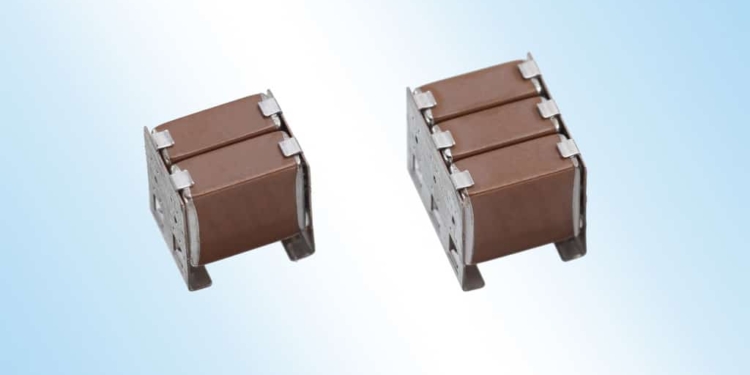Source: TDK news
TDK Corporation has developed a new series of vertically stacked MEGACAP Type MLCCs that combine high capacitance and low ESR.
The new CA series offers rated voltages from 25 V to 1000 V and covers a capacitance range from 20 nF to 150 µF. The new MLCCs are available with C0G, X7T, X7S, and X7R temperature characteristics. Thanks to their high capacitance values, the new capacitors are suitable for the resonant circuits of wireless and plug-in charging systems, for example, for industrial vehicles and robots. They can also be used in smoothing and decoupling applications in industrial equipment. Production of the CA series began in April 2018. Automotive grade products will be introduced after mid-2018.
The MEGACAP Type MLCCs feature metal lead frames attached to the electrode ends of the components to protect against board flexure cracks and solder cracks from thermal shocks. The metal material of the terminal has also been optimized to lower the ESR and achieve a higher ripple current capability. In order to enable a low profile with increased capacitance, TDK has adapted its MEGACAP stack design so that the MLCC elements are stacked side by side. The vertically stacked design enables stacks with three or even more elements. Hybrid joints between the metal terminals and the MLCC are both soldered and clamped to prevent the individual MLCC elements from falling out of the lead frame at the increasingly higher reflow temperatures. The CA series will be available initially with 2x and 3x stacks. In the future the lineup will be expanded with 5x stacks. TDK offers a broad portfolio of MLCCs for a wide range of applications. TDK will continue to place a special focus on the development of technologically superior automotive grade MLCCs.
Main applications
- Resonant circuits for wireless and plug-in charging systems
- Smoothing and decoupling applications in industrial equipment
Main features and benefits
- High capacitance enabled by stacked design
- Low ESR due to optimized terminal material
Key data
| Type | Temperature characteristic | Rated voltage [V] | Capacitance [F] | Stacked elements | Dimensions [mm] |
|---|---|---|---|---|---|
| CAA572C0G3A203J* | C0G | 1000 | 20n | 2 | 2x stack:6.1 x 5.6 x 6.4 3x stack:6.1 x 8.4 x 6.4 |
| CAA572C0G3A303J* | 30n | 2 | |||
| CAA572C0G3A443J* | 44n | 2 | |||
| CAA572C0G3A663J* | 66n | 2 | |||
| CAA573C0G3A993J* | 99n | 3 | |||
| CAA572C0G2J204J* | 630 | 200n | 2 | ||
| CAA573C0G2J304J* | 300n | 3 | |||
| CAA572X7T2J105M** | X7T | 630 | 1μ | 2 | 2x stack:6.1 x 5.0 x 6.4 3x stack:6.1 x 7.5 x 6.4 |
| CAA573X7T2J155M** | 1.5μ | 3 | |||
| CAA572X7T2W225M** | 450 | 2.2μ | 2 | ||
| CAA573X7T2W335M** | 3.3μ | 3 | |||
| CAA572X7S2A336M** | X7S | 100 | 33μ | 2 | |
| CAA573X7S2A476M** | 47μ | 3 | |||
| CAA572X7R1V107M** | X7R | 35 | 100μ | 2 | 2x stack:6.4 x 5.0 x 6.8 3x stack:6.4 x 7.5 x 6.8 |
| CAA573X7R1V157M** | 150μ | 3 | |||
| CAA572X7R1E107M** | 25 | 100μ | 2 | ||
| CAA573X7R1E157M** | 150μ | 3 |
*Production begin: April 2018 (AEC-Q200 qualified products after mid-2018)
**Production begin: July 2018 and onward































